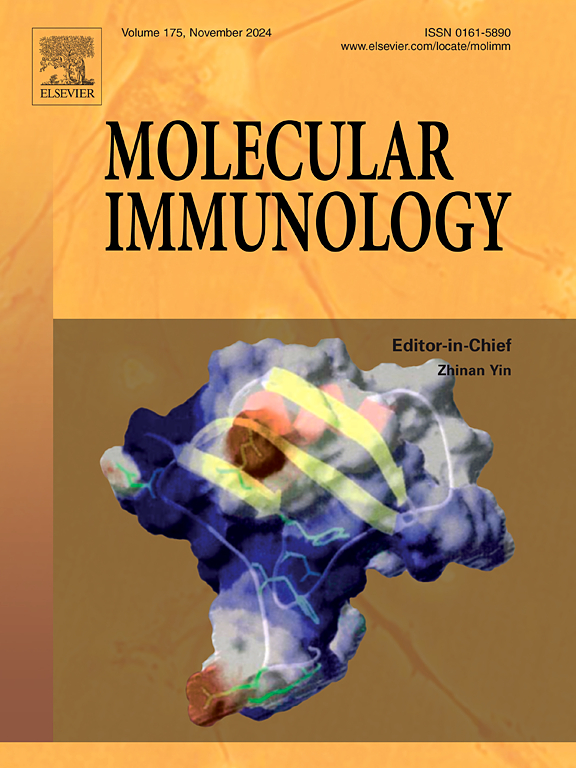补骨脂素不仅能诱导肿瘤细胞和巨噬细胞的焦亡,还能增强自然杀伤细胞的细胞毒性,抑制肝癌的发生
IF 3
3区 医学
Q2 BIOCHEMISTRY & MOLECULAR BIOLOGY
引用次数: 0
摘要
补骨脂素是中药补骨脂的主要成分,它是从豆科植物补骨脂的干燥成熟果实中提取的,具有多种药理作用,包括抗肿瘤作用。然而,补骨脂素预防肝细胞癌(HCC)的机制尚不清楚。在我们的研究中,我们发现补骨脂素诱导HepG2和Hepa1-6细胞的焦亡和GSDME (gasdermin E, GSDME)的裂解,而这一过程被caspase-3抑制剂Z-DEVD-FMK逆转。此外,补骨脂素诱导线粒体活性氧(ROS)产生,导致caspase-3激活和随后的GSDME切割。有趣的是,补骨脂素通过ROS-NLRP3炎性小体-gasdermin D (GSDMD)诱导巨噬细胞热亡,导致白细胞介素(IL)-1β和IL-18的分泌,从而促进自然杀伤细胞(NK)的活化和抗肿瘤能力。在小鼠模型中,补骨脂素抑制HCC生长,诱导肿瘤细胞焦亡,增强T细胞和NK细胞的肿瘤浸润。综上所述,我们的数据表明,补骨脂素通过ROS/caspase-3/GSDME诱导肿瘤细胞焦亡,并通过ROS/NLRP3炎性体/GSDMD触发巨噬细胞焦亡,增强NK细胞抗肿瘤能力,提示补骨脂素可作为HCC的潜在治疗候选药物。本文章由计算机程序翻译,如有差异,请以英文原文为准。
Psoralidin induces pyroptosis in both tumor cells and macrophages as well as enhances nature killer cell cytotoxicity to suppress hepatocellular carcinoma
Psoralidin is a major component of the traditional Chinese medicine Psoraleae Fructus, which is derived from the dried mature fruit of the leguminous plant Psoralea corylifolia L. and possesses many pharmacological effects, including anti-tumor effects. However, the mechanism through which psoralidin protects against hepatocellular carcinoma (HCC) remains unclear. In our study, we found that psoralidin induced pyroptosis and gasdermin E (GSDME) cleavage in HepG2 and Hepa1–6 cells, which were reversed by the caspase-3 inhibitor Z-DEVD-FMK. Moreover, psoralidin induced mitochondrial reactive oxygen species (ROS) production, leading to caspase-3 activation and subsequent GSDME cleavage. Interestingly, psoralidin induced pyroptosis in macrophages via ROS-NLRP3 inflammasome-gasdermin D (GSDMD), leading to the secretion of interleukin (IL)-1β and IL-18, which promoted natural killer (NK) cell activation and its anti-tumor capability. In a mouse model, psoralidin suppressed HCC growth, induced tumor cell pyroptosis, and enhanced tumor infiltration of T and NK cells. Collectively, our data demonstrate that psoralidin induces pyroptosis in tumor cells via ROS/caspase-3/GSDME and triggers pyroptosis in macrophages via ROS/NLRP3 inflammasome/GSDMD, enhancing NK cell anti-tumor ability, suggesting that psoralidin could be used as a potential therapeutic candidate for HCC.
求助全文
通过发布文献求助,成功后即可免费获取论文全文。
去求助
来源期刊

Molecular immunology
医学-免疫学
CiteScore
6.90
自引率
2.80%
发文量
324
审稿时长
50 days
期刊介绍:
Molecular Immunology publishes original articles, reviews and commentaries on all areas of immunology, with a particular focus on description of cellular, biochemical or genetic mechanisms underlying immunological phenomena. Studies on all model organisms, from invertebrates to humans, are suitable. Examples include, but are not restricted to:
Infection, autoimmunity, transplantation, immunodeficiencies, inflammation and tumor immunology
Mechanisms of induction, regulation and termination of innate and adaptive immunity
Intercellular communication, cooperation and regulation
Intracellular mechanisms of immunity (endocytosis, protein trafficking, pathogen recognition, antigen presentation, etc)
Mechanisms of action of the cells and molecules of the immune system
Structural analysis
Development of the immune system
Comparative immunology and evolution of the immune system
"Omics" studies and bioinformatics
Vaccines, biotechnology and therapeutic manipulation of the immune system (therapeutic antibodies, cytokines, cellular therapies, etc)
Technical developments.
 求助内容:
求助内容: 应助结果提醒方式:
应助结果提醒方式:


